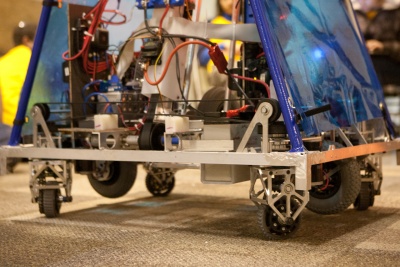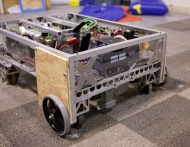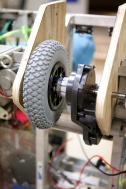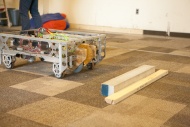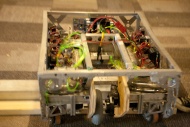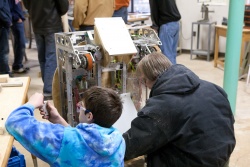DEWBOT VIII Drive Train
- Ability to cross the mid-field line via either the Bridge or going over the Barrier (Need)
- The ability to drive in the wide orientation in order to fit three robots on a Bridge (Need)
- The ability to drive in the wide orientation to facilitate ball pick-up from the playing field (Need)
- Avoid blocking robots, especially between Key & Bridge (Desired)
- Ability to lock wheels on the Bridge to avoid rolling off when power is cut (Desired)
While not a specific strategic requirement, it was perceived that the ability to drive in the narrow orientation would make crossing over the Barrier safer & easier.
Furthermore, if pivot drive was used, it was decided that the shooter would be aimed my rotating the robot, rather than via a rotating turret (not applicable if tank drive was selected). The logic was that pivot drive enabled the entire robot to become a turret, so we should exploit this and avoid a redundant turret.
Team 1640's signature Pivot drive-train seemed to meet some of the game's requirements very well (especially driving in either wide or narrow orientations), but how would be get over the Barrier? 1640's pivots had always used 4" wheels in the past. No way they're going over a 4" Barrier, right?
Contents
Reflection
Crossing the Barrier is a Need? Really? Yes, it is certainly do-able, but this capability is likely to be expensive in terms of mass, cost and compromises made to other (perhaps more critical) capabilities.
Concepts
Initial concepts included:
- A 6wd wide chassis (like DEWBOT V) with 8" Pneumatic wheels (or larger)
- 8" Pneumatic wheels (or larger) in-line with pivots, either outside or inside between, either undriven or driven
- A ramp and skid-plate in-line with pivots and between them
- Redisign pivot drive for 8" Pneumatic wheels (or larger)
It was decided to pursue ooptions 1-3 via prototyping and testing. Option 4 was discarded due to mechanical considerations and limitations in design resources.
Prototypes
6wd Wide Tank with 8" Pneumatic Wheels
- The DEWBOT V chassis was allocated to test this concept. Unfortunately, work did not proceed at a sufficient rate and this concept was not tested before a decision needed to be made (and therefore never tested). Too bad.
8" wheels in line with Pivots
- Based on the geometric understanding that (a) large-diameter wheel(s) in-line with and either outside (safer) or inside (more practical) the two pivots on a short side of the robot would protect the pivota and raise the robot up to the barrier top and lower it (safely?) back down.
- Testing used the DEWBOT VI chassis. Initial testing used unpowered 8" KitBot wheels outboard of the Pivots. This configuration failed to clear the Barrier. A second version utilized a powered 8" AndyMark pneumatic wheel between the pivots.
- This worked and became the basis of DEWBOT VIII's drive-train design.
Skid-plate in line with Pivots
- We tested polypropylene skid plates in lieu of the 8" pneumatic wheel. This works if the angle of attack is low enough. Unfortunately, the necessary angle of attack does not leave enough space for anything else.
Decision
On 14-January, we made the decision to proceed with Pivot Drive using 4" wheels in combination with (2) 8" Pneumatic wheels positioned along the chassis long-axis centerline with the axles in-line with the pivot centerpoints. 8" wheels are 5/8" off the flat playing field. One FisherPrice drive motor with a 104:1 BaneBots gearbox will drive both wheels, with a further 38:32 reduction via synchronous belt & pulleys (123.5:1 overall reduction).
To save mass, this motor/gearbox will also drive the Beater Bar.
Drive Modes
Specific drive modes were developed for Rebound Rumble. These are:
- Fat Snake - Primary drive mode - snake drive with a wide chassis orientation.
- Skinny Snake - Used primarily for crossing the Barrier - Pneumatic wheels are automatically driven in the direction of robot travel while in this mode.
- Aiming mode - Orients wheels on a circle and rotates chassis about center. For shooting and chassis reorientation. Unlike previous DEWBOTS, this mode remains on until specifically turned off.
- Crab mode - Primarily for evasion
Pivot Drive changes since 2011
The team repeated the value engineering excercise on the pivot design. In 2011, we did not experience reliability problems with the pivot modules, so our focus was on:
- Eliminating the need for separate left and right pivot modules, thereby elininating the need to bring separate left and right spares to competitions;
- Steer straight better
- Reduce mass
- Reduce cost
We clearly succeeded with the first and the last two objectives. Initial driving tests suggest we succeeded with the second as well (but let's give this some time).
All 2012 pivot modules are identical. All angle sensors are calibrated to the same relative zero point, so no calibration is needed with a pivot module swap.
Pivot drive train (4 pivot modules) mass has declined from an original 40.0 lbm (2010) to 37.2 lbm (2011) and now to 34.5 lbm (2012).
Pivot drive cost was reduced by over 9% (following FRC robot accounting rules) from 2011 to 2012.
Pivot Drive Specifications
- Wheelbase: 21.25" x 28.25"
- Drive Motors: CIMS - 1 per wheel
- Wheels: 4 in AndyMark Plaction wheels
- Gear Reduction: 8.30:1 in 2 stages (56:18 by HTD5 synchronous belt & pulleys; 24:9 by #35 chain & sprockets)
- Maximum Speed: 9.8 ft/s on level ground
- Steering Motors: BaneBots M3-RS395-12 - 1 per wheel
- Steering Reduction: BaneBots 3-stage 132:1 planetary gearbox; transmitted 1:1 via HTD5 synchronous belt with 32T pulleys
- Maximum steering speed: 1.96 rev/s (unloaded)
